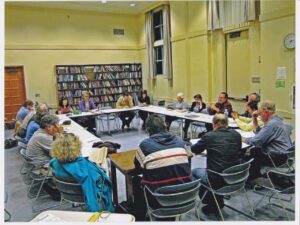[imagesource:wikicommons]
Underneath the French city of Reims lies approximately 200km of underground cellars that have become known as ground zero for the Champagne world. It has become a popular tourist attraction for those who worship the bubbly fruit juice and every year travellers visit these underground cellars to explore the history of Champagne.
It is in these caves that a little-known history of Champagne played out at the hands of widows who found a loophole in ancient French law.
During the Napoleonic era, women were restricted from owning businesses in France without permission from a husband or father. The law however said nothing about widows, and after losing their husbands, several french women used these caves to completely transform the champagne industry. Among them were Barbe-Nicole Clicquot-Ponsardin, Louise Pommery and Lily Bollinger. The names might ring a bell.
One of the widows, Barbe-Nicole Ponsardin, married François Clicquot, who then ran his family’s small textile and wine business, originally called Clicquot-Muiron et Fils. Following his death, his 27-year-old widow decided to take over the business.
“It was a very unusual decision for a woman of her class. It would have been extremely unusual for her to have a business, because she didn’t need to… She could have spent her life in drawing rooms and as a society hostess.”
Barbe-Nicole however wasn’t a ‘normal woman’ and approached her father-in-law for a loan of €835,000 to keep the business going. He amazingly said yes, and seeing as she was a widow, she used this as a ‘marketing tool’, renaming the business Veuve Clicquot-Ponsardin – veuve translating to widow in french.
“The ‘veuve’ suggested a certain kind of respectability to the beverage… some of these beverages had gotten associated with the debauchery and wild parties of the royal courts of old.”
The other widows followed in her footsteps and soon they changed their names to Veuve Binet and Veuve Loche. According to Kolleen M Guy, author of When Champagne Became French: Wine and the Making of a National Identity, companies that ‘didn’t have a widow at the head of the household would create kind of off-brands, like a veuve off-brand, so they could try to capture this trend’.
Despite Barbe-Nicole’s best efforts, the business nearly closed down again, and when she secured another loan from there father-in-law, the border closure during the Napoleonic wars further frustrated her efforts to move her products.
Barbe-Nicole however was not deterred and despite border closures, she went to Russia to find a new market for her champagne.
She knew that if she could get her product into Russia before Jean-Remy Moët, who was her arch-rival, she would be able to capture some market share.
She smuggled thousands of bottles into Russia and within 90 days went from just another importer to being known as ‘The Widow’. Fearing that her supply lines would peter out if she was unable to ensure more product, she then set about speeding up the production process. The most tedious part was the extraction of dead yeast cells from the bottles, and here also, Barbe-Nicole had another trick up her sleeve.
She instructed her workers to cut holes into her kitchen table, and insert the bottles upside down. This way the dead yeast would lie at the top of the bottle and could be easily extracted. This technique became known as “riddling” and today it is a critical part of the Champagne-making process.

[imagesource:veuveclicquot]
Barbe-Nicole and the other widows fundamentally changed how Champagne was produced and in their own way made the beverage better than ever before. If you want to have a taste of this formidable lady’s product, you can head on down to Cafe Du Cap in Newlands, where Veuve Clicquot is always available, and always cold.
Perhaps the next time you raise a glass of Veuve Clicquot you might want to propose a toast to the widows who changed the world one bubble at a time.
[source:bbc]





